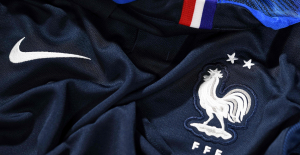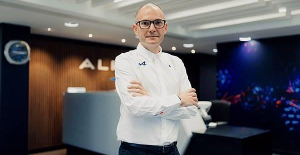Exploring the oceans continues to be one of the last frontiers for the human being and the appearance of small commercial submarines has come to cover the desire for adventure of the most daring millionaires.
The case of the disappearance of the British businessman Hamish Harding, the adventurer who wanted to contemplate the remains of the Titanic, may endanger the growing industry created around these artifacts.
These are small submarines designed for between 5 and 7 people to discover the remains of large ships or enjoy the fauna and flora of the depths.
Some luxury cruise ships already offer this service and have incorporated one or two submarines on their ships so that their exclusive passengers can live the experience of knowing the bottom of the sea. A ticket in these devices for a half-hour dive can cost up to 1,000 euros per traveler. Each one of the submersibles costs around 5 million euros, an investment that more and more companies are willing to assume given the interest that these trips arouse.
Diving into one of these devices is a unique experience, but only suitable for those who do not suffer from claustrophobia. Just getting into these devices already requires being in a certain physical shape and some travelers are unable to do so because of the anguish it can create. Once inside, the sensation of seeing how the water completely covers the travelers and the immersion begins is memorable.
A Spanish traveler who has just had the experience says that "the moment of being covered by water was exciting, something I had never experienced before", but he admits that the visibility was low and in this sense he expected more from the immersion. Regarding the sensations, he recalls that everything seemed safe to him, but he explains that a fellow traveler, a British national, could not enter the submarine, despite having signed up for the excursion proposed by the cruise. "Claustrophobia got the better of him and he wasn't able to get in," he recalls.
Once inside, the straits continue. Some of the submarines that have now become popular on cruise ships have a central body where the pilot sits and two large transparent spheres on the sides where six passengers sit, three on each side. The glass is several centimeters thick and travelers are required not to wear rings on their hands to prevent scratches and obscuring vision. Visibility for passengers is complete, although very clear water is required to be able to see clearly.
The pilot's first notice to the travelers inside the submersible (in many cases they are airplane pilots converted to this industry) tries to reassure the passengers by saying that there is enough oxygen to be lost or in difficulty for four days.
This issue is key in the case of the Titan, the missing submersible that has the planet counting the hours that the submersible still has left. Its autonomy is 96 hours. The deadline for her to return to the surface with her crew safely ends Thursday at 9 in the morning.
In the case of cruise ships, the risk of submersibles being launched into the water is fairly controlled since they only go down to between 15 and 30 meters deep and always close to the ship, although they have the capacity to submerge up to 300 meters.
In the case of Titan, the OceanGate ship in which Harding was traveling, the depth is much greater and the search becomes very complex because the remains of the Titanic are found in a remote place in the middle of the Atlantic.
OceanGate organizes eight-day trips to see the remains of the famous ocean liner, which lies more than 500 km from Newfoundland, Canada, and 3,800 meters below the sea. The price of these expeditions amounts to $250,000, according to the company on its website.
While the Titanic submarine focuses its activity on searching for information that helps to understand the mysteries that the ship holds, other submersibles are solely for recreation. In the Caribbean, where prices are more popular, there is a long tradition of commercial submarines that allow up to 40 people to go down into the depths.
This hobby is now reaching Europe, where the Mediterranean can become a great place to discover sunken shipwrecks, especially from the World War II era.
Many of the growth plans of this industry could be stopped dead if Titan does not return to the surface.

 What is chloropicrin, the chemical agent that Washington accuses Moscow of using in Ukraine?
What is chloropicrin, the chemical agent that Washington accuses Moscow of using in Ukraine? Poland, big winner of European enlargement
Poland, big winner of European enlargement In Israel, step-by-step negotiations for a ceasefire in the Gaza Strip
In Israel, step-by-step negotiations for a ceasefire in the Gaza Strip BBVA ADRs fall almost 2% on Wall Street
BBVA ADRs fall almost 2% on Wall Street Sánchez cancels his agenda and considers resigning: "I need to stop and reflect"
Sánchez cancels his agenda and considers resigning: "I need to stop and reflect" The Federal Committee of the PSOE interrupts the event to take to the streets with the militants
The Federal Committee of the PSOE interrupts the event to take to the streets with the militants Repsol: "We want to lead generative AI to guarantee its benefits and avoid risks"
Repsol: "We want to lead generative AI to guarantee its benefits and avoid risks" Osteoarthritis: an innovation to improve its management
Osteoarthritis: an innovation to improve its management The yen jumps 3% then falls again, amid speculation of Japanese intervention
The yen jumps 3% then falls again, amid speculation of Japanese intervention A very busy Friday on the roads of Île-de-France before the Ascension Bridge
A very busy Friday on the roads of Île-de-France before the Ascension Bridge Fraud: the government is preparing new measures for the fall
Fraud: the government is preparing new measures for the fall Nike breaks the bank to keep the Blues jersey
Nike breaks the bank to keep the Blues jersey Madonna ends her world tour with a giant - and free - concert in Copacabana
Madonna ends her world tour with a giant - and free - concert in Copacabana Harry Potter: Daniel Radcliffe “really saddened” by his final breakup with J.K. Rowling
Harry Potter: Daniel Radcliffe “really saddened” by his final breakup with J.K. Rowling Leviathan, New York Trilogy... Five books by Paul Auster that you must have read
Leviathan, New York Trilogy... Five books by Paul Auster that you must have read Italy wins a decisive round against an American museum for the restitution of an ancient bronze
Italy wins a decisive round against an American museum for the restitution of an ancient bronze Omoda 7, another Chinese car that could be manufactured in Spain
Omoda 7, another Chinese car that could be manufactured in Spain BYD chooses CA Auto Bank as financial partner in Spain
BYD chooses CA Auto Bank as financial partner in Spain Tesla and Baidu sign key agreement to boost development of autonomous driving
Tesla and Baidu sign key agreement to boost development of autonomous driving Skoda Kodiaq 2024: a 'beast' plug-in hybrid SUV
Skoda Kodiaq 2024: a 'beast' plug-in hybrid SUV The home mortgage firm rises 3.8% in February and the average interest moderates to 3.33%
The home mortgage firm rises 3.8% in February and the average interest moderates to 3.33% This is how housing prices have changed in Spain in the last decade
This is how housing prices have changed in Spain in the last decade The home mortgage firm drops 10% in January and interest soars to 3.46%
The home mortgage firm drops 10% in January and interest soars to 3.46% The jewel of the Rocío de Nagüeles urbanization: a dream villa in Marbella
The jewel of the Rocío de Nagüeles urbanization: a dream villa in Marbella Europeans: a senior official on the National Rally list
Europeans: a senior official on the National Rally list Blockade of Sciences Po: the right denounces a “drift”, the government charges the rebels
Blockade of Sciences Po: the right denounces a “drift”, the government charges the rebels Even on a mission for NATO, the Charles-de-Gaulle remains under French control, Lecornu responds to Mélenchon
Even on a mission for NATO, the Charles-de-Gaulle remains under French control, Lecornu responds to Mélenchon “Deadly Europe”, “economic decline”, immigration… What to remember from Emmanuel Macron’s speech at the Sorbonne
“Deadly Europe”, “economic decline”, immigration… What to remember from Emmanuel Macron’s speech at the Sorbonne These French cities that will boycott the World Cup in Qatar
These French cities that will boycott the World Cup in Qatar Mercato: Verratti at Barça? A track studied
Mercato: Verratti at Barça? A track studied Rugby: after the defeat during the Six Nations, the Blues will meet the English in September for a test match
Rugby: after the defeat during the Six Nations, the Blues will meet the English in September for a test match Premier League: Liverpool unveils its new jersey for next season
Premier League: Liverpool unveils its new jersey for next season Formula 1: Alpine holds its new executive technical director
Formula 1: Alpine holds its new executive technical director


















